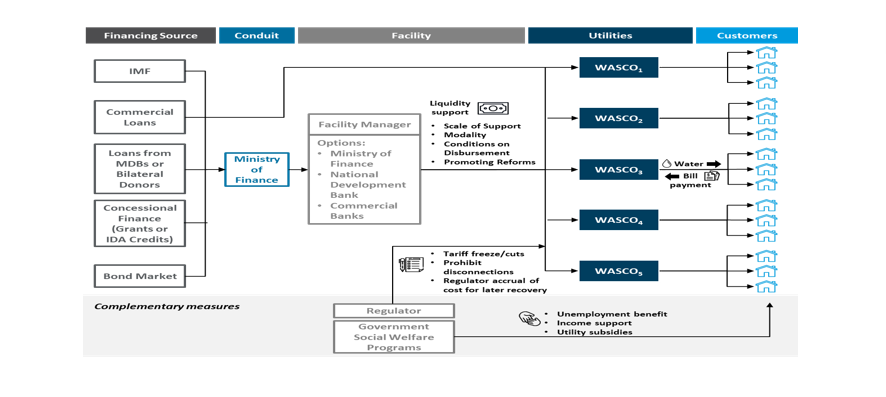Last week Castalia posted a blog about how Liquidity Facilities could be the solution to providing emergency financial support to water utilities in response to the COVID-19 pandemic. We received a lot of interesting comments about the relevance of this topic (for example, U.S. water utilities actively lobbying Congress to get stimulus money to compensate for their COVID-related losses) and thoughtful questions about the detailed design of these Facilities.
So the Chief Executive of Castalia, David Ehrhardt (DE) answered some of the frequently asked questions about the options in the design of a Facility.
Question 1: How should the scale of required financial support be assessed?
DE response: In this fast-moving crisis, we need quick options to assess financial need. These include existing utility financial models and a World Bank model created for this purpose (COVID-19 Financial Impact Assessment Tool for Water Service Providers). These can be done utility by utility and then added up for a national estimate. Alternatively, data from other similar countries could be used if available. Obviously, you should do high and low scenarios as well as a base case.
Question 2: Will the Facility be a national body, or could it be regional or subnational?
DE response: Almost all Facilities will be at the national level because the money in the Facility has to come from (or be guaranteed by) the national government. That being said, there could be exceptions such as a regional facility for small nations with regional institutions already in place (such as the Organization of Eastern Caribbean States); or a state-level Facility in Federal Systems with states or provinces having responsibility for water (as in Brazil, Nigeria, and India).
Question 3: Which entity will manage the Facility?
DE response: Using existing institutions to manage the Facility will make the Facility quicker to get up and running. Some options for a Facility Manager include:
- A national development bank (such as BNDES in Brazil) or water sector financing agency (such as LWUA in the Philippines)
- A unit in the Ministry of Finance that has experience running government grant or loan schemes and fiscal transfers
- A bank operating under contract to the government with strict guidelines and clear responsibilities, or offering loans with government guarantees (similar to the US Paycheck Protection Program for general business continuity), again with clear guidelines and responsibilities
- A regional development bank or monetary authority (such as the OECS Central Bank or the Caribbean Development Bank), in those cases where a regional fund is judged to be appropriate.
Question 4: What monitoring and fiduciary arrangements are needed?
DE response: At a minimum, the Facility will need a Procedures manual; agreements or contracts with the recipient utilities; accounting systems; clarity on the role of the independent auditor; and clarity on the role of the regulatory entity.
Question 5: What sources can finance the Facility?
DE response: In the majority of cases, the government is going to have to put up the money, or at least guarantee it. In developing countries, the government’s first source of finance during this crisis is likely the IMF and then multilateral and bilateral development finance institutions. To pay out large amounts of cash to water utilities, the government will need to borrow large amounts of money and potentially borrow more money over time. It, therefore, makes sense to set up a Facility that can aggregate money from several different sources at several different times.
Question 6: How will funds be disbursed from the Facility to utilities?
DE response: This is a great question. I think that the modality for disbursement should be loans because the Facility can get the money out the door quickly while also encouraging performance improvements and minimizing fiscal costs (of course, there could still be a fiscal cost because some utilities may default on their loan. In these cases, the disbursement could be converted to a grant). Another good option is for the government to guarantee lending from a commercial bank because it shifts the burden of loan administration to the commercial bank and brings utilities and banks together. All that being said, grants are obviously the simplest, quickest option.
Question 7: Should the Facility attempt to promote utility reforms?
DE response: I think that, at the very least, the designer of the Facility should consider attaching reform requirements to assistance from the Facility. Water utilities, and importantly, their inefficiencies, are finally getting the attention of the Minister of Finance. This creates a rare opportunity to have multi-level stakeholder support for vital reforms. Of course, though I encourage considering promoting reforms, the designer of the Facility must remember that the overriding aim must be to quickly get money to utilities in sufficient quantities to allow them to remain operational.
DE closing remarks: Thank you for all of your thoughtful questions. Please comment to let us know your thoughts and if you think we have missed some important option or consideration. I look forward to continuing this discussion with all of you. If anyone reading needs help with these questions, please let me know
Interviewed by: Lisa Nations.
This is Clive Harrison‘s second update to his spreadsheet-based pandemic model. The original model was posted on this blog on April 22 and the first update was posted on May 4.
The disease was spreading too quickly in my updated model. The proportion of asymptomatics is not as high as I believed the Swedish data was suggesting. The problem was/is that the numbers of deaths for the final 14 days or so of each edition of the published data are incomplete, so are revised upwards in subsequent editions with data arriving from the regions. That meant that the rapid fall in the death rate after a peak the data seemed to show when I last wrote was just artefact of the data collection system. You can see this in the attached worksheet, in the two charts below the Sweden data in “Common and calibration data”.
I followed this for a few weeks to see how the process works and then, this week, I felt I could make a reasonable estimate the adjustments that will take place over the next few weeks to obtain a sensible set of calibration data. It is clear that my model cannot replicate the smooth and prolonged log-linear decline in the actual numbers of daily deaths in the latest data using the numbers of cases implied by the very low mortality rates I was using last time.
To match the latest data I reduced the number of cases by increasing the mortality rate. The model started to approach a calibration at a mortality rate of 0.1%. I also looked again at the actions the Swedish authorities took in March. These included limits on meeting sizes and some distancing restrictions and recommendations in mid-March tightened somewhat at the end of March. You can see from the data that, contrary to popular belief, the Swedes and their government have been very effective at limiting the rate of spread, apart from a blip in care homes for the elderly that was quickly dealt with.
I used a second distancing phase match the tightening of the distancing measures in late March, which shows in the data, and tried calibrating the model for mortality rates of 0.1%, 0.2%, 0.3%, 0.4% and 0.5%. The rates above 0.1% do a better job of modelling the log-linear decline in the numbers of deaths, but the higher mortality rates require increasingly long doubling times. I think that rates of 0.2%, 0.3% and 0.4% give the best calibration results.
I kept the second distancing rate going until daily deaths fell to zero but then I always end up with a big ‘second wave’, sometimes months later. I introduced a third distancing phase to deal with this and experimented with that for mortality rates of 0.15%, 0.2% and 0.25% (which seemed to give the best calibrations). Fine-tuning this third distancing phase eliminates a ‘second wave’ altogether and shows that the final death toll is very sensitive to its timing and intensity.
If you have the time, it is worth playing with the four variables that control the third phase (in cells AF5, AD8, AF8 and AD9), while keeping the calibration values for the first and second distancing periods unchanged, and seeing how the final death toll (in cell G51, under the chart) responds. In the model, it seems that the best policy, to minimise the overall number of deaths, would be an immediate and controlled relaxation of distancing. This leads to a temporary increase in the number of daily deaths but an earlier end to the epidemic. In Sweden the second peak is below the first one, so would not over-stretch the medical resources, but that is unlikely to be the case in countries with much larger populations.
Death is a tricky subject. The increase in life expectancy in most places since 1945 is one of the many benefits of the global civilisation that has taken root since then and is currently being tested by this epidemic (among other things). Most people now die when they are old, which necessarily also means that most people who die are old. Some day, something, little or large, will tip each of us over the edge and into oblivion. At the moment COVID-19 is one of those things and wrinklies like me naturally make up the majority of the casualties. This is no excuse for negligence or disregard for the welfare and treatment of the elderly, but it’s not a reason for a lot of hand-wringing either.
The data seems to show that most Swedes have responded very effectively. Apparently traffic reduced immediately as people took fewer journeys and various other statistics show that responsible self-restraint has worked very well. I see that that there is now some internal dissent there because their death rate is much higher than in Norway and Denmark, where stricter measures were introduced. I think that the difference comes from Sweden being much closer to an end of the epidemic than their neighbours and that the final death tolls are probably a year away. When those numbers finally emerge they will probably be explained by demographic differences and the incidence of co-morbidity factors in the general population.
I hope that the Swedish government sticks to its guns and treats its people like the responsible citizens they seem to be, as an example to almost all the other governments in the western world.
Download the updated model here.
Water utilities are critical for fighting COVID-19
In the absence of a vaccine or treatment for COVID-19, there is no better cure than prevention. Access to water, especially for hand-washing, (along with social distancing) is proven to be the most important method in preventing the spread of the pandemic, particularly in high density, low income communities. Keeping the taps running at this critical juncture, and expanding access to safe water, can save perhaps millions of lives as the scale of the COVID-19 pandemic unfolds.
But the effects of COVID-19 are making it difficult for water utilities to continue operations
At this time, when the sustainability and resilience of water service provision is paramount to the COVID-19 response, water utilities are finding it increasingly difficult to cover their costs. This is caused by the double burden of increased costs and decreased revenues. In many instances, costs are increasing due to pandemic-related operational costs like personal protective equipment and workplace adjustments; and government-mandated obligations like the expanded provision of public standpipes, water tankers, and hand-washing facilities. At the same time, revenue collection is falling due to a drop in industrial demand and the inability of household customers to pay their bills. Indicative information from World Bank client countries shows that the financial crisis has already reached many water utilities and that the impact on revenues is dramatic. Some figures indicate that revenue collected could have decreased by as much as 70% in the first few weeks of the pandemic. This dramatic drop in revenues could cause catastrophic declines in service, especially because most utilities in developing countries do not have cash reserves to fall back on.
Under normal operating conditions, utilities use disconnection of service to ensure payment of bills. But, for understandable reasons, utilities are not using this tool now, because they are choosing not to or because they have been told not to by governments and regulators. US’s National Association of Clean Water Agencies estimated that the impact of suspending water shutoffs, restoring connections to delinquent accounts, and reductions in non-residential water will result in a US$12.5 billion loss in utility revenues across the country.
A Liquidity Facility could be the solution
Given the essential services provided by water utilities, national leaders need to prioritize getting money to water utilities. A Liquidity Facility could be the vehicle to achieve this.
- What is it? A Liquidity Facility is an entity or instrument to channel funds to water utilities to enable them to provide essential services
- How would it work? In most cases, the national government[1] would first need to find a source of finance (examples include their own-source revenues, government commercial borrowing, government proceeds from the IMF, government borrowing from international development banks). The money would then flow from the national government to the Facility (often through their Ministry of Finance). Finally, the money would flow from the Facility to the utilities
- How could this solve the problem? This could solve the problem because the Facility would be able to pay out a large amount of money fairly quickly to utilities
- When would it be appropriate? A Facility would be most appropriate in countries with many water utilities. For a country with one national water utility a solution tailored to that utility, rather than a Facility serving multiple utilities, could be more appropriate .
The detailed design of the facility will take many different forms, depending on the local context. To set up a liquidity facility, the designer of the facility needs to answer a set of questions, including:
- What is the scale of financing required?
- Where is the money going to come from?
- Who should manage the Facility?
- What should be the modality of disbursement?
Several development agencies are currently working on these questions with governments in several countries. The issues described above must urgently be addressed so that water utilities can deliver and expand services during the COVID-19 crisis. We encourage all policy makers, utilities, international finance institutions, donors, NGOs, and other water sector stakeholders to begin the discussion to answer these questions now.
Thank you!
To all of our readers who work at utilities, thank you for your continued public service in the face of COVID-19 risks and implications. We, at Castalia, are proud to call you our valued partners and we are energized to support and work in solidarity with you during this difficult time.
Please let us know how we can help, including if you need assistance related to this topic (such as advising on the development of the argument to advocate for the prioritization of water sector funding; or on the design of the liquidity facility).
[1] Note that we say, “In most cases, the national government would first need to find a source of finance” because there are cases where water utilities in developing countries are able to access commercial finance. In these cases, a Facility would not be needed. However, in most developing countries, water utilities are not commercially viable. Therefore, the national government will be required to provide the money that will keep them operational.
Authors: Lisa Nations and Shannon Riley.




